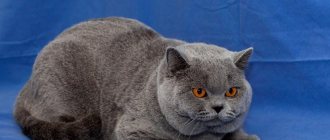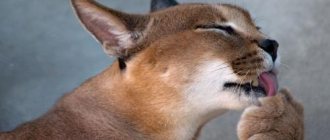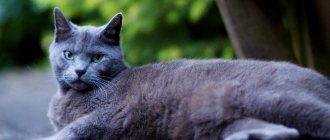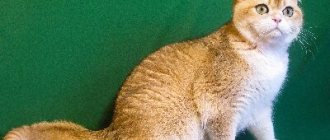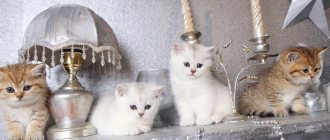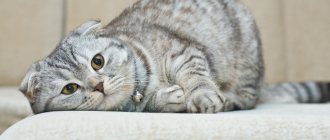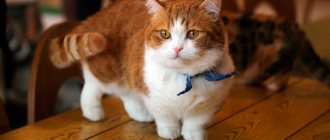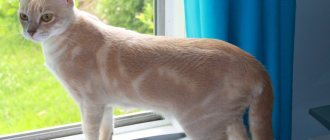What does a British cat look like?
Everyone knows what a British cat looks like, but not everything is so simple. Purebred individuals have many features that are not noticeable at first glance, which distinguish them from mestizos. In the photo, the British cat does not look as luxurious as in life.
Muzzle
The head of the British breed is quite large, with full cheeks and a round forehead. There is a flat space between your pet's ears. The individual has very expressive eyes. They are large in size and have a round shape. The eyes are widely spaced from each other. The color of the irises depends on the color of the animal itself. They can be green, blue, copper or yellow. There are animals with eyes of different colors.
Cats are characterized by a short, wide, straight nose. According to the standard, the pet's chin and earlobe should form a vertical line. The color of the lobe also depends on the color of the animal's coat.
The ears of a British cat are small in size with slightly rounded tips and straight in shape. They widen towards the base of the skull.
Body type
Animals can be of medium or large build. British cats are 4-6 cm taller than female cats. The weight of male and female individuals can reach up to 4-8 kg.
The body of the animal is folded proportionally. It is powerful due to the strong muscles given to cats from birth. The chest is wide and quite deep. The Briton's back is short, but at the same time massive.
The front and rear legs are straight and stand strictly parallel. They are not very long and have strong bones. The paws are round and powerful. The fingers fit tightly to the pads.
The animal's tail, wide at the base, is rounded at the end. It itself is not very long, but quite thick and powerful.
Coat and color
According to standards, wool is the main feature of the British breed. Thus, the undercoat and main hair are almost equal in length. This is what creates the plush effect. Due to the thick undercoat, the guard hairs cannot fit tightly to the animal's body.
For representatives of the British breed, a wide variety of colors is acceptable. The breed standard allows for approximately 60 color options for a British cat. Solid colors are considered classic. The most popular among them are:
- blue, or lilac color, the basis of which is rich gray for blues or silver with shades of peach or pink for lilacs;
- black and chocolate color, with a slightly lighter undercoat;
- white, which may appear as snow white or beige-cream with a white undercoat.
These days, cats with monochrome colors are quite rare. Therefore, combinations of different colors also have their own names:
- tortoiseshell is a very interesting combination of black and red colors, sometimes with white splashes;
- tabby is the most popular color inherited from wild relatives, combining stripes on the back of the animal, the letter M on the forehead, and a ring in the tail area;
- Chinchilla is a light smoky or gray shade in which the guard hair is not completely colored.
Tabbies have spotted, brindle and marbled patterns. Varieties of the British cat are not distinguished by color or other criteria.
Solid colors of the British
Some of the solid (with an emphasis on the "o"), or solid colors - such as blue - are the ancestors of the British colors, and some - new colors - were obtained through the labor-intensive work of breeders. The rarest solid colors are cinnamon and fawn.
White
Snow-white without yellowness. Kittens may have black or gray spots on their heads from birth, which disappear with age. The eyes can be blue, and heterochromia (difference of eyes) also occurs. Breeding experiments with this color have ended because too many kittens are being born with health problems. For example, deafness in white cats with blue eyes is common.
Black
The coal-black, raven-wing colors of British cats give the animal a witchy, magical appearance. But, unfortunately, it is difficult to guess that a black kitten will become a blue-black cat. Very often, kittens change color around six months, changing the color of their fur to chocolate.
Chocolate
The richer and darker the better. Kittens that have faded from black are usually not the most successful (brown) color. Noble dark chocolate is desirable.
Blue
It can be a little lighter and a little darker. The bluer the shade, the more valuable it is. The undercoat is sometimes lighter than the main hairs, but the difference should be minimal.
Lilac
A complex color that is a cross between blue and pink. The result of selection work. Kittens are born dull pink; With age, the animal acquires a light coffee-with-milk shade, with a pinkish tint.
Cream
Beige or peach shades. Kittens can be born with a variegated coat, but then the variegation goes away.
Faun
"Deer" color, even lighter than cinnamon cinnamon. In infancy, such a kitten can be confused with a cream kitten, but the older the pet, the more clearly the gray tone appears (in cream cats, red predominates).
Cinnamon (cinnamon)
A rare color, cinnamon color, similar to light chocolate with the addition of an orange tint.
British cat character
British cats are a very unusual combination of the appearance of a plush toy with a rather willful character.
On the one hand, they have a pronounced attachment to the owner, a desire to cuddle up to him, to receive their portion of caresses and strokes. On the other hand, pets do not like intrusion into their personal space. The unobtrusive presence of a person in their life is important to them.
The pet spends a lot of time contemplating the surroundings from the windowsill in the apartment, and if the cat lives in a country house, it will find a convenient place for observation in the yard.
The Briton gets along well with other animals. He easily makes friends with cats, dogs, and is calm about pet birds or fish. But in any communication or game, a purebred individual will want to be a leader and will try to show his superiority.
Discreet and also very silent adult pets have a great time with children. They steadfastly endure an excess of affection from the little man.
Some owners note sudden moments of cat activity. They can run around the house at high speed after a real or imaginary object.
The character of the British cat is generally balanced, and the animal can suit almost any family.
Habits
The bright character traits of the British directly influence their habits. Some people believe that since animals belonging to the presented breed are quite obedient, then they cannot do any bad things, but this is not so.
Common negative habits include:
- Scratching and biting hands.
- Throwing objects off surfaces.
To somehow compensate for this, many people want to know how the British are doing with catching mice, and this is a completely different matter.
Catching mice
British cats are often called clumsy. It is impossible to argue with this, but this does not prevent them from being excellent rat-catchers and mouse-catchers. If you believe history, the French always took cats of these breeds with them on voyages so that they would keep an eye on supplies and leave no chance for rodents to profit from various delicacies.
It is rare to find mice in modern apartments, so even with a strong desire, it would be difficult for cats to try to hunt someone. Another thing is animals that live in private sectors and in dachas. Pet owners have repeatedly noted that cats are very agile and excellent hunters. Some people believe that since they managed to cope with the rodent, they should definitely feast on it, but this is not so. Representatives of felines catch mice and rats for fun, they do not even understand that this is food that should be eaten. The reason lies in the character of the British cat, which was taught from childhood to a place for food. Having played enough, the animal leaves its prey and goes on about its business.
Biting and scratching
Scratching and biting the hands of their owners is a favorite activity of four-legged animals. At the age of three or four months, the kitten begins to bite the hands and sometimes the legs of a person. This is directly related to the change of teeth in animals. There is no need to think that such a habit will go away on its own. If the situation continues for a month, the animal will realize that it is possible to do this and in the future you will not wean it from it. At the same time, there is no need to try to beat the baby or shout at him; it is not his fault that his teeth itch. It needs to be done much simpler - during an attack, put a soft toy or mouse on your hand, which will interest the pet and become its favorite victim in the future.
Dropping items
Throwing objects off the table is an equally interesting activity. It can be anything, from a pen to a flower pot. Among the main character traits, self-indulgence is not listed among the British, but for them it is not self-indulgence, but curiosity. Cats are very interested to see how the object will fly down and what will happen to it after. If you want to stop this, then you should either sprinkle the surface with a pungent odor that animals cannot tolerate, or make the surface so that the pet does not have the slightest chance of climbing on it. At the same time, you must not forget about toys for your pet so that he does not have to get bored.
Raising a British cat
In fact, the British are almost impossible to train. But they can be made quite well-mannered by teaching the basic rules of living in the house.
The first thing a kitten is introduced to upon arrival at a new place of residence is the litter box. At first the baby will be confused, but the owner needs to patiently monitor his behavior. If the cat is worried and sniffs the corners, he is taken to the litter box. It usually takes a couple of weeks to develop good toilet habits. We must not forget to praise the little Briton, but there should be no concessions for mistakes either.
Weaning your cat off begging, as well as trying to steal from the table, is very important for maintaining good animal health. Human food causes allergies and is also very harmful due to the abundance of spices and preservatives. Creating a proper feeding schedule and a balanced menu will help you get rid of this habit.
If a British cat does not walk outside, then problems arise with its sharp claws. Scratched furniture and damaged interior items become a big problem for an animal that is not trained in time. You need to accustom your baby to a scratching post immediately after entering the house. It is necessary to persistently take your pet to this object whenever you try to sharpen its claws on foreign objects.
Love, patience and stubbornness in the good sense of the word will help the owner of the British breed to raise an obedient pet that will become the pride of the owner.
Looking for a British Shorthair cat? Find your pet from 12 offers As a gift
Features of the fold-eared white British
The British Fold white cat is an unrecognized breed by the felinological community due to identified health deficiencies. A distinctive feature from the white solid is the peculiar shape of the ears, the tips of which are slightly bent inward, as if hanging down. Otherwise, white fold-eared British cats are similar in body size and head shape to white British cats (long-eared), but are considered to be of different breeds. At birth, fold-eared cats are also susceptible to defects such as deafness and poor vision, like white solid cats. They have a similar eye color, and odd-eyed specimens appear. The fur of snow-white folds is soft and plush to the touch.
British cat health
Possible diseases
Experts classify the British cat breed as healthy individuals. It cannot be said that they never get sick. But there are no genetic diseases unique to the British. These animals are susceptible only to those ailments that affect all purebred animals.
Common heart problems include hypertrophic cardiomyopathy. It causes thickening of the wall of the ventricle, leading to disruption of the functioning of this organ, and if neglected, to death.
A blood clotting disorder is caused by hemophilia. This disease is dangerous due to large blood loss or internal bleeding. In representatives of the British breed, it can occur due to the crossing of closely related individuals. There is no treatment that completely eliminates hemophilia, so they are limited to blood transfusions and the use of iron supplements. Animals with this problem should not be part of the breeding process.
The British inherited the dangerous kidney disease polycystic disease from the Persian cat breed. It is characterized by the formation of tumors filled with fluid, which causes disruption of the urinary system. At the very beginning, the symptoms of the disease are not very noticeable, so they recognize it already at a fairly advanced stage. The only way to help your pet is by surgical removal of single cysts.
Otherwise, drug treatment is used, but it will simply relieve the animal’s pain and prolong its life by only a few months or a year.
Your pet's mouth can be affected by gingivitis, a disease that causes inflammation of the gums. If you don't start fighting it right away, it spreads to the ligaments, as well as the bones. As a result, teeth begin to fall out, and the infection spreads through the bloodstream throughout the cat’s body.
Overeating or abuse of treats from the host's table leads to the development of food allergies, as well as dermatitis.
Like all breeds, the British are recommended for comprehensive vaccinations, which are carried out under the supervision of a veterinarian on a schedule. The use of anthelmintic drugs will help get rid of intestinal parasites.
Reproductive health
Before getting a British cat, decide whether you need kittens in the future. If not necessary, then take care of sterilization or castration of the animal at a young age.
The optimal time for these procedures is 1 year of the pet’s life. Before this age, surgery should not be performed, because the reproductive organs of cats and kittens are not yet fully mature. Timely castration has a significant impact on the health of British cats and seals.
In the case of desired offspring, the female is considered ready for pregnancy at the age of one and a half years. Typically, gestation occurs without complications; as a result of childbirth, an average of 4-5 babies are born.
When to adopt a kitten?
The ideal age for moving to a new family is 3 months (12 weeks). During this time, the kitten receives the necessary nutrition from the mother, breast milk actively builds immunity, and also allows the baby to develop properly. It is at this age that kittens already weigh about 2 kg. Also at this age, kittens learn from their mother the rules of behavior and caring for their appearance. A responsible breeder provides the necessary vaccinations up to 3 months and carries out preventive work, treating babies against helminths.
The ideal age for a kitten to move to a new family is 3 months.
Features of feeding and diet
The appearance of a British cat, as well as its physical condition, depends on a properly balanced diet. The owner independently decides what to feed the pet. This can be natural food, ready-made food or a mixed menu.
Natural feeding involves the owner drawing up a special menu that can provide the cat not only with calories, but also with nutrients. It would be a good idea to enrich your food with vitamin and mineral supplements.
The natural type of food includes lean meats: beef, lamb, chicken, turkey or rabbit. The recommended amount of meat products is at least half of the daily diet. Sometimes cats are given boneless sea fish fillets, beef liver or tripe. The rest of the diet should consist of cereals and vegetables.
Among cereals, preference is given to oatmeal, rice or buckwheat. Vegetables are added boiled or stewed. Milk can only be beneficial for kittens up to 6 months old. Adults should receive low-fat fermented milk products and cottage cheese.
British people should not be given:
- sweets;
- flour;
- salted or smoked fish;
- tubular bones;
- river fish.
Ready-made food is convenient to use because it can be stored for a long time, is fully balanced and already enriched with useful substances.
Combined feed is a combination of natural and industrial feed. The only rule that must be followed is not to mix homemade food and purchased food in one feeding.
A British cat should have clean water in his bowl at all times.
Where is the best place to get a kitten?
It is better to purchase a British kitten from nurseries; it is advisable to find reviews (they must be positive about this breeder). When the kitten turns 3 months old in the nursery, it will be ready to move to a new family, and the breeder will be able to prepare the necessary documents and give the baby vaccinations. This age is also favorable for the baby himself; his immunity will be more or less formed, which means the kitten will get sick less.
Before taking the baby to a new home, you need to examine him so that there is nothing suspicious in appearance and the kitten looks healthy and active. Ask the breeder about the maintenance of the kitten, its nutrition, and read the pedigree of the parents.
Before purchasing a kitten, it is important to study its pedigree and talk to the breeder.
British kittens are distinguished from others by their plush dense coat, round eyes, compact, muscular body with a wide chest. These kittens also have a thick tail and full, short legs. The head should be round, with a wide muzzle, dense nose pads and cheeks.
When purchasing a kitten from a specialized nursery, you can be sure that:
- kitten from purebred parents;
- the veterinary passport reflects all vaccinations performed, including treatment against helminths;
- the kitten will have the metric to participate in exhibition events.
Characteristics of the British cat
more about the standard, characteristics of a British cat , as well as caring for it on our website.
Care and maintenance
The British give their owners a lot of joy, but they also require a lot of attention. What causes the most trouble is their thick, very dense coat. It is not prone to tangling, tangles do not form on it, but the fur still needs regular combing. Carry out the procedure no more than twice a week, using a soft brush with natural bristles. During seasonal shedding, which occurs in spring and autumn, lost hair is combed out more often. This helps prevent excessive hair from appearing on furniture, carpets and clothing.
Veterinarians recommend occasionally giving your animal tablets to dissolve hair. When licking, especially during the molting period, cats swallow hair. Once in the stomach, they are practically not excreted and cause problems in the gastrointestinal tract.
Washing your British cat with special shampoos should not be done too often. The coat of the breed has a natural fatty coating, which serves as a barrier to the development of infections and the penetration of bacteria. If necessary, bathing is carried out very carefully, trying not to get water into the eyes or ears.
The cat's ears and eyes need to be wiped with a cotton pad soaked in a special lotion. To remove dirt and discharge from the eyes, you can use cooled boiled water. The cleaning procedure must be carried out at least once a week.
No more than once a month, the claws are trimmed with special nail clippers, and then polished to remove any roughness with a nail file.
Unlike most decorative breeds, British cats can be walked outside. The individual's good immunity allows him to take long walks, but in large cities there is a serious danger of being attacked by stray dogs or being run over by cars. To avoid accidents, wear a harness and leash on your cat.
In any case, cats of the British breed require sufficient physical activity to prevent pet obesity. The tendency to overeat can be corrected by following feeding standards and portion sizes.
Caring for and maintaining a British cat will not become a problem if you train yourself to regularly carry out hygiene procedures with your animal.
Toilet training a kitten
As soon as the kitten appears in the house, you need to immediately accustom it to the new tray. At first, the baby may be disoriented in a new room and needs help. You also need to consider the location and access to the toilet, because British cats, although clean, have their own opinions. Therefore, if a kitten refuses to go to the new litter box, then you should not think that he is stupid and does not understand anything. In fact, British cats are very smart, and therefore, most likely, the new tenant simply does not like something. Perhaps the tray needs to be moved a little, moved to another corner, or the filler changed.
Instincts tell the kitten that all waste needs to be buried, so choose the appropriate substance for the toilet, because the “British” are clean. If you do not pay attention to this, the kitten may begin to mischief and look for another place to relieve itself.
Training a kitten to use the litter box
If you suddenly find a puddle on the floor, you should not scold the kitten, much less beat it; with this method of education you can provoke the baby to do things secretly in the wrong place. It is better to show your pet in a dissatisfied tone that you are not happy with this situation, and, having collected the puddle with toilet paper, take it to the tray. This way the smell will attract the kitten to go to the right place. It is also worth watching the animal; usually after the baby has eaten, he runs to the toilet. Monitor the kitten's path to the toilet, and then the baby will remember that things need to be done in the litter box.
Don't lose your temper if the kitten doesn't go to the toilet the first time. Remove puddles with special odor-eliminating products that can be purchased at a pet store. Be persistent with your pet and show him where to go, but do not hit him or scream if he suddenly misses. The kitten will sooner or later understand what is required of him, the main thing is to be patient.
In the nursery, cats teach kittens to be clean, so babies come to their new home with toilet knowledge
Tips for choosing a kitten
Purchasing a British pet in Russia will not cause any difficulties, since this breed is very popular in our country. Unfortunately, due to increased demand, unscrupulous sellers offer animals with hereditary diseases and unclear pedigree. Only experienced breeders, as well as specialized nurseries, can sell decent British kittens.
The kitten should be taken from its mother no earlier than two and a half or three months. By this time, the baby’s immunity will be stronger, and he will develop the skills necessary for independent living. After two months of age, cats receive their first comprehensive vaccination and rabies vaccination. This must be reflected in the veterinary passport.
Before purchasing, it is important to observe the behavior of your future pet and take a closer look at its fur. It should be smooth and shiny. Eyes should be clean and free of inflammation. The belly should be soft and covered with silky hair. Meet the kitten's parents and ask for pedigree documents. If everything is in order, the acquired baby will bring you only joy.
WHITE BRITISH KITTENS: PHOTOS OF SMALL KITTENS
We are pleased to present photos of white British kittens.
| In our cattery you can “buy a real British kitten.” We have many different colors, we will help you choose and answer all your questions! |
How much does a British cat cost?
The cost of a British baby directly depends on the popularity of the nursery, the pedigree of the parents, and compliance with appearance standards. The color of the individual may also affect the price. Some of the most common are blue or chocolate kittens with yellow eyes. But color-point chinchillas and chinchillas with emerald irises are sold much more expensive.
Sellers will offer a cat suitable as a companion for no more than 3-10 thousand rubles. If the baby acts as a breeding animal or in exhibitions, then the price of a British cat will reach 35-50 thousand rubles.
Tabby colors
The main signs of a tabby (or wild color) are the letter M located on the animal’s forehead (according to legend, this is the sign of a scarab), dark stripes near the eyes and on the cheeks, as well as rings (necklace) on the neck and chest.
Marbled Tabby
Dark circles, swirls and patterns on a light background. The pattern should be clear, not tangled or intersecting.
Spotted Tabby
Stripes on the cheeks, a dotted stripe along the ridge, and spots on the sides, preferably clearly defined and bright, are required. The cat is a micro-leopard.
Striped tabby
Brindle (sprat, mackerel, striped) is the most common tabby color. Mackerel (mackerel) fish, as well as sprat fish, have tiger stripes on their scales, just like cats have on their fur, hence the name.
Distinctive features are a dark stripe along the ridge, extending onto the tail, and striped sides. It is important that the stripes are not interrupted and do not turn into spots. The cat is a micro-tiger.
Patterned with white (torbico)
Quite a rare color, consists of three: tabby, tortoiseshell, white. On a white background there are colored spots with one of the tabby patterns.
Pictured tortoiseshell (torby)
The animal has a tabby pattern under any of the coat colors (black-red, chocolate-red, blue-cream, lilac-cream, as well as cinnamon-red and fawn-cream).
Silver tabbies
The cat's fur has a black pattern (stripes, spots, marble), and a white and silver undercoat.
Golden tabbies
The cat's fur has a red pattern (stripes, spots, marble), and an apricot undercoat.
Feeding a kitten with natural products
List of foods not recommended for cats:
- fatty meats (pork, lamb);
- raw poultry meat and bones (chicken, turkey);
- any raw fish;
- sausages, sausages, smoked cheeses, chocolate, etc.;
- food that a person eats (salty, spicy, sweet).
A diet based on natural products includes the following items:
- lean meat (frozen beef, chicken, turkey, rabbit) - about 8-100 g/day. depending on the age of the kitten;
- offal (liver, heart, kidneys) - 10-100 g/day;
- boiled sea fish without bones no more than once a week gj 6-80 g/day;
- dairy products (cottage cheese - 3.5-20 g/day, kefir, low-fat sour cream no more than 10 g per day, cheese);
- chicken and quail eggs in the amount of 50-55 g per week;
- vegetables (cucumber, carrots, cauliflower, zucchini) - 10-40 g/day;
- cereals (buckwheat, wheat, rice) - 10-80 g/day;
- vitamin and mineral complex (according to instructions).
A balanced diet is the key to the correct and healthy development of the baby.
Table 3. Kitten consumption rate of natural food
| Age | Number of times per day | Daily norm |
| 1-3 months | 5-6 times | 150 gr. |
| 4-6 months | 4-5 times | 240 gr. |
| 7-10 months | 3-4 times | 280 gr. |
| More than 10 months | 2 times | 250-300 gr. |
What do you need to know? Choose wide, flat dishes for your pet to make it easier for him to eat.
